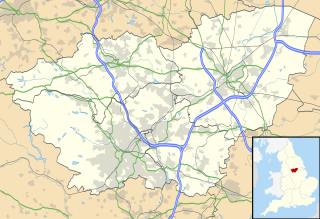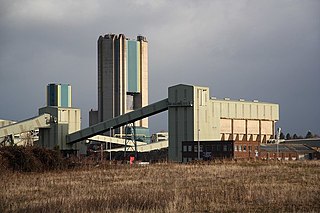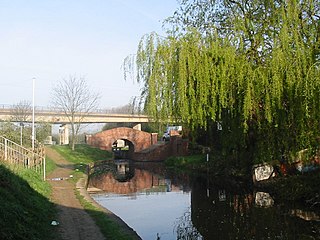
Anston is a civil parish in South Yorkshire, England, formally known as North and South Anston. The parish of Anston consists of the settlements of North Anston and South Anston, divided by the Anston Brook.

Kiveton Park, informally Kiveton, is a village within the Metropolitan Borough of Rotherham, in South Yorkshire, England. Historically a part of the West Riding of Yorkshire, from the Norman conquest to 1868, Kiveton was a hamlet of the parish of Harthill-with-Woodall. It subsequently transferred to the civil parish of Wales which takes its name from the neighbouring village.

Hackenthorpe is a village 5 miles south east of Sheffield’s city centre, now classed as a historic township of the city. Due to much expansion, the village became a part of Sheffield city during the 1950s. During much of the late 19th and 20th centuries the village was noted for its steelmaking, with the Thomas Staniforth & Co Sickle works being based at Main Street. Another prominent feature of the village is the 17th century Hackenthorpe Hall, built by John Newbould for the Hounsfield family, with James Hounsfield being a prominent land owner. The building is today used as a nursery.

Harworth is a small town in the county of Nottinghamshire, East Midlands of England. It is approximately 8 miles (13 km) north of Worksop. Together with the neighbouring mining town of Bircotes, it forms the civil parish of Harworth and Bircotes, with a combined population of nearly 8,000 residents. The population of the civil parish was measured at 7,948 in the 2011 Census. The settlements are part of the modern district of Bassetlaw, which combined the district of Worksop and the district of Retford.

Rhodesia is a village and civil parish located in the county of Nottinghamshire in England. The population of the civil parish was 982 at the 2011 census. The village lies just outside the town of Worksop in the district of Bassetlaw and lies approximately 20 miles from Sheffield. It was named after the erstwhile chairman of the nearby Shireoaks Colliery, G. Preston Rhodes.

Shirebrook railway station serves the town of Shirebrook in Derbyshire, England. The station is on the Robin Hood Line, 21½ miles (35 km) north of Nottingham towards Worksop.

Orgreave Colliery was a coal mine situated adjacent to the main line of the Manchester, Sheffield and Lincolnshire Railway about 5 miles (8 km) east of Sheffield and 3.5 miles (6 km) south west of Rotherham. The colliery is within the parish of Orgreave, from which it takes its name.
Treeton Colliery was a coal mine situated in the village of Treeton, near Rotherham, South Yorkshire, England.

Rother Vale Collieries were a group of coal producing pits originally in the Rother Valley parishes of Treeton, Woodhouse and Orgreave, nowadays on the south east Sheffield / Rotherham boundary, in South Yorkshire, England. In the early 20th century a new colliery at Thurcroft was developed.
Kilnhurst Colliery, formerly known as either Thrybergh or Thrybergh Hall Colliery, was situated on the southern side of the village of Kilnhurst, near Rotherham, South Yorkshire, England.

Kiveton Park Colliery was a coal mine in the village of Kiveton Park, near Rotherham, South Yorkshire, England.
Warren Vale Colliery was a coal mine, also known as Piccadilly Colliery, situated alongside Warren Vale Road, between Rawmarsh and Swinton, South Yorkshire, England, in the valley of the Collier Brook, which runs east, for about two miles towards Kilnhurst.
Aldwarke Main Colliery was a coal mine sunk in the Don Valley, near Rotherham, South Yorkshire, England.

Roundwood Colliery was a coal mine situated in the Don Valley, about 2 miles north of Rotherham, South Yorkshire, England on the borders of Rotherham and Rawmarsh.
Aston Colliery was a small coal mine sunk on Aston Common, within Rotherham Rural District but six miles east of Sheffield in the 1840s. In 1864 its workings were taken over and developed by the North Staveley Colliery Company, part of the Staveley Coal and Iron Company, based in North Derbyshire. It was later acquired by the Sheffield Coal Company.
Pilsley railway station was a station in the village of Pilsley in Derbyshire.
Dinnington Main Colliery was a coal mine situated in the village of Dinnington, near Rotherham, South Yorkshire, England.
The Clowne Branch is a lifted but protected former railway line in north eastern Derbyshire, England, currently being developed as part of the greenway network for walkers, cyclists and horse riders.
Beighton Junction is a set of railway junctions near Beighton on the border between Derbyshire and South Yorkshire, England.

The Burnley Coalfield is the most northerly portion of the Lancashire Coalfield. Surrounding Burnley, Nelson, Blackburn and Accrington, it is separated from the larger southern part by an area of Millstone Grit that forms the Rossendale anticline. Occupying a syncline, it stretches from Blackburn past Colne to the Yorkshire border where its eastern flank is the Pennine anticline.







